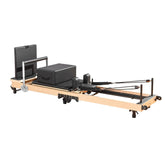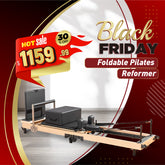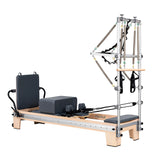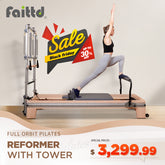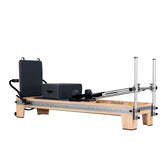Pilates Reformer 101: A Step-by-Step Guide for Newbies
Starting with Pilates reformer exercises can be an exciting step in boosting your fitness routine. The reformer is a great machine that can help you build strength, flexibility, and balance using controlled movements. If you are a beginner, no problem; it's all about learning the basics to keep your workouts safe and effective. This guide will walk you through everything from picking the right equipment and basic safety tips to essential exercises and gradually tackling more advanced moves. You'll focus on the fundamentals of breathing and core engagement, which will get you stronger and more balanced in no time.
How Do You Get Started with a Pilates Reformer?
When you are ready to dive into Pilates reformer workouts, the right equipment will be everything. Here's how you can decide:
Types of Reformers
- Studio Reformers: These are larger, heavier-duty machines that are found in professional settings; many feature adjustable bars and springs for a customizable workout experience.
- Home Reformers: Smaller and lighter, these are perfect for personal use. Folding capabilities or wheels for easy storage are common in many models; hence, they are good if space is limited at home.
- Portable Reformers: These are meant to be more portable—than studio models—and easier to store, although they might compromise on some stability compared to studio models.

Features to Look For
In choosing features, consider adjustable springs to change the level of resistance, which suits the needs of different strengths and flexibility. Comfortable padding for support in exercises, while sturdy construction ensures stability and safety. The adjustability of the footbar is also very important for customizing various exercises and body sizes..
Basic Safety Tips for Beginners
To get started safely with the Pilates reformer, a few simple guidelines have to be followed: Give some time to familiarize yourself with the equipment; know how each part works, and, specifically, the mechanical use of adjusting springs and correct usage of straps. Second is proper attire; fitted and comfortable clothes for better movement and to prevent them from getting in between the apparatus.
Second, one should keep the area around the reformer clear. This ensures that one has enough space to move without hindrance and minimizes the chances of accidents.
What Are the Essential Safety Steps for Using a Pilates Reformer?
At the initial stage of using the Pilates reformers, safety should not be compromised. Here's how you can prepare effectively:
Familiarize with Equipment
Know your reformer equipment for safe use. Take some time to understand how each component works, such as adjusting the springs, the footbar, and the straps. Understanding the basics of how these work will help in making much better use of the machine and avoiding certain mishaps. If at all possible, consult an instructor or watch videos for a better understanding of the mechanics involved.
Proper Clothing
Wearing appropriate attire also makes a big difference in every workout. Wear fitted, stretchable garments that move with and do not constrain you, nor would it cause you any concern getting caught in moving parts on the reformer. Exclude loose-fitting clothes and accessories that would get caught up in the equipment because this is likely to give you various accidents or stops during exercise.
Clear Space
Safety also includes having an uncluttered working-out area. Ensure there is space around the reformer to move around comfortably without bumping into anything. This will prevent falls or injuries and allow you to focus on your exercises without distractions. Taking these precautions will set the stage for a safe and effective Pilates reformer practice.
What Are the Basic Principles of Pilates You Should Know?
Understanding the basic principles of Pilates can ensure an effective workout to make sure you get the best out of your sessions on the reformer. Here are three core principles to guide your practice:
Breath Control
Breath control is a foundational element of Pilates, helping to enhance movement efficiency and focus. In Pilates, breathing is typically deep and rhythmic, engaging the diaphragm fully; inhale through the nose, fill your lungs, and exhale through the mouth. Proper breath control supports stability and power during exercises, oxygenates your muscles, and helps maintain concentration throughout your routine.
Core Engagement
Core engagement is another key principle in Pilates. Sometimes referred to as the "powerhouse," the core includes the abdominal muscles, lower back, hips, and glutes. Engaging these muscles provides stability and balance, improving posture and protecting the spine. During exercises, focus on drawing your navel toward your spine to effectively engage your core and support both movement precision and safety.
Mind-Body Connection
The full benefits of Pilates can be realized with the mind-body connection. This principle of mindful movement requires being cognizant of each motion, and controlling it with intention. Paying attention to what your body is doing helps execute exercises properly and safely. It will also provide more insight into how your body moves, making you more fit in the process.

What Are the Starting Exercises You Can Do on a Pilates Reformer?
Basic exercises on the Pilates reformers can set the foundation for a successful practice. Here are three beginner-friendly exercises to start with:
Footwork Series
The Footwork Series is an excellent way to warm up and establish proper alignment and leg strength. To perform this exercise, lie on your back with your head on the headrest and feet placed on the footbar. Start by pressing out, extending your legs straight with your core on, then lower to your starting position by bending at the knees. This series generally includes variations such as toes, arches, heels, and wide V for different parts of the lower body.
The Hundred
The Hundred is a classic Pilates exercise that addresses breathing, core stability, and endurance. Lying on the reformer with your legs either in tabletop position or extended at a 45-degree angle to the body, engages your core. Lift your head and shoulders off the carriage, and extend your arms down by the sides. Begin to pump arms up and down with vigor, inhaling for five counts and exhaling for five counts, with ten complete breaths. This is great for firming abdominals and increasing circulation to the area..
Leg Circles
The leg circle improves hip mobility and activates the core. Lie down on your back with extended legs up to the ceiling, held by the straps. Your arms can remain at your sides for support. Engage your core and make circles in the air with your legs, keeping your pelvis stable throughout. Continue to do the circles in both ways: clockwise and counterclockwise. This will equally help the hip joint and surrounding muscles.
What Are the Intermediate Exercises You Can Try on a Pilates Reformer?
Once you're comfortable with the basics, progressing to intermediate exercises on the Pilates reformer can further enhance your strength and flexibility. Here are two key exercises to incorporate into your routine:
Short Box Series
The Short Box Series focuses on core strength, spinal mobility, and posture. You’ll perform these exercises sitting on the reformer’s short box with your feet secured under the foot strap. Key movements include:
- Round Back: Sit tall with a straight spine, arms crossed over your chest or extended in front. As you exhale, scoop your abdominals and round your lower back, leaning back slightly, and then return to an upright position.
- Flat Back: With a straight spine, hinge back from the hips while keeping your back flat and your core engaged, then return to the starting position.
- Side-to-Side: Sit tall and hinge from side to side at the waist, maintaining stability in your hips and engaging your obliques.
These variations promote balance, control, and increased abdominal strength.
Pelvic Bridge
The Pelvic Bridge is excellent for strengthening the glutes, hamstrings, and lower back while enhancing hip mobility. Begin by lying on your back with your feet on the footbar, knees bent, and arms by your sides. Press through your heels to lift your hips off the carriage, creating a straight line from your shoulders to your knees. Hold at the top briefly before slowly lowering back down. To add intensity, try variations like single-leg bridges, where one leg extends upward as you lift your pelvis.

How Do You Incorporate Resistance Changes on a Pilates Reformer?
Incorporating resistance changes on the Pilates reformer is essential for tailoring workouts to your fitness level and goals. Here's how you can effectively adjust spring resistance:
Adjusting Spring Resistance
Understanding how to adjust the spring resistance on your reformer is crucial for controlling the intensity of your exercises. Springs provide varying levels of resistance, which can range from very light to extremely heavy. Here's what you need to know:
- Identify Spring Colors: Most reformers use color-coded springs to indicate different resistance levels. Familiarize yourself with what each color represents on your specific machine, as this will help you quickly select the appropriate resistance.
- Adjust According to Exercise Type: Lighter springs are typically used for exercises focusing on control and stability, such as certain core or balance movements. Heavier springs, on the other hand, are useful for strength-building exercises that target larger muscle groups like leg presses or arm pulls.
- Customize for Personal Needs: As you become more experienced, you'll want to adjust the resistance based on your personal strength and flexibility. Increasing resistance can make an exercise more challenging and build muscle strength, while decreasing it can help improve precision and control.
- Experiment with Variations: To optimize your workout, experiment with different spring combinations during various exercises. This allows you to target muscles differently and enhance overall conditioning.
What Are the Tips for Effective Pilates Practice?
To effectively maximize your Pilates reformer workout, here are some important tips that can help improve effectiveness and safety:
Consistency is Key
The key to observing progress in Pilates is regular practice. Do practice at least two to three times a week to develop strength, flexibility, and stamina. Continuous practice helps to reinforce muscle memory, improve technique, and increase your general fitness level with time. Setting a consistent routine also helps you stay motivated and committed to your fitness goals.
Listening to Your Body
Paying attention to your body's signals during each session is vital for preventing injury and ensuring an enjoyable workout experience. If you feel discomfort or pain beyond the usual muscle fatigue, adjust the exercise, modify the resistance, or take a break. It's important to differentiate between challenging yourself and overexerting. Also, allow time for rest and recovery, as this is when muscles rebuild and strengthen. Trust your instincts and make adjustments as needed to keep your practice safe and effective.
Start Your Pilates Reformer Journey Today!
Pilates reformer exercises can bring great improvement in your fitness and overall health. You will be building strength, flexibility, and balance by starting with foundational exercises and working your way up to more challenging movements. Consistency is key—make Pilates a part of your routine, and, above all, listen to your body for a safe, enjoyable practice. Commit to it now: set realistic goals, take charge of your health, and enjoy the miracle changes this mindful exercise regime can bring into your life.
FAQs for Pilates Reformer Beginners
1. What is a Pilates reformer?
A Pilates reformer is a piece of exercise equipment used in Pilates workouts to improve strength, flexibility, and posture. It consists of a flat platform, the carriage that rolls back and forth on wheels within a frame, and uses springs for resistance.
2. How often should I use the Pilates reformer?
It is recommended to practice on the reformer two or three times a week for results in strengthening, flexibility, and overall fitness. Consistency is important for achieving full benefits.
3. Can beginners use a Pilates reformer?
Yes, beginners can use a Pilates reformer. Many exercises are suitable for all fitness levels, and you can adjust the spring resistance to match your abilities. It's helpful to start with a class or guided session to learn proper techniques.
4. Do I need special clothing for Pilates reformer exercises?
Wear comfortable, fitted clothes that don't chafe and are less likely to get caught in the machine. Avoid loose clothing or accessories such as jewelry that can get in the way of your workout.
5. Is Pilates reformer safe for people with injuries?
Modifications can be made in the Pilates reformer exercises for people with specific injuries or conditions; however, this is best discussed with a healthcare provider or certified Pilates instructor to ensure that proper modifications are considered.
6. How does Pilates reformer differ from mat Pilates?
The main difference is in the equipment and resistance: Mat Pilates relies on body weight and gravity, while the Reformer provides springs and pulleys for extra resistance, offering more varied exercises and greater mobility.
